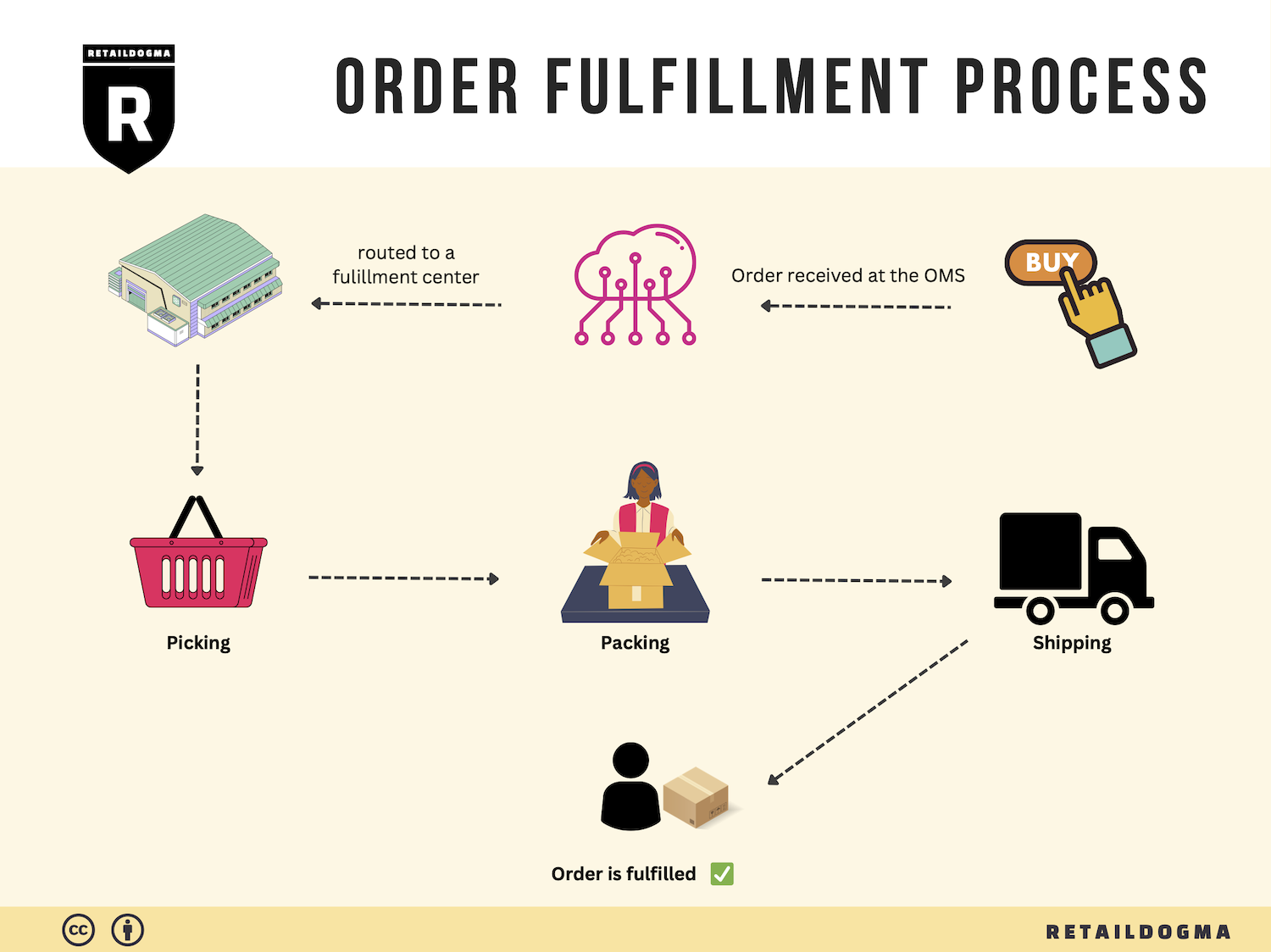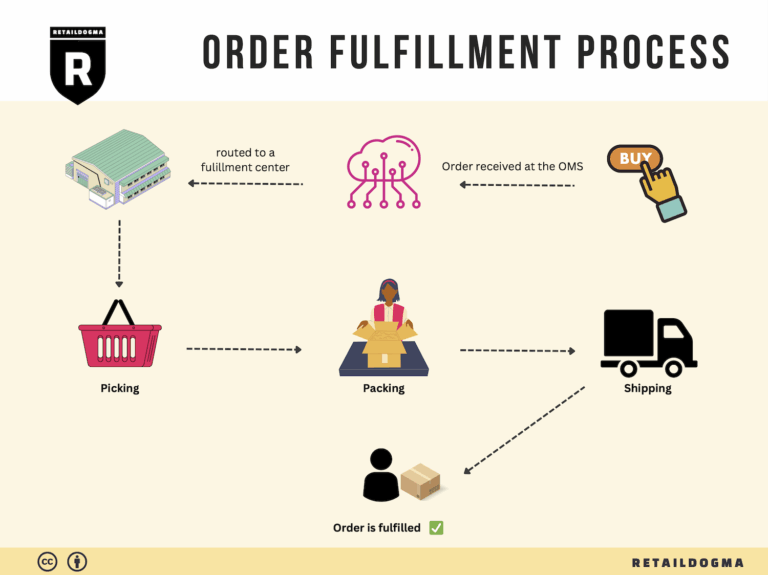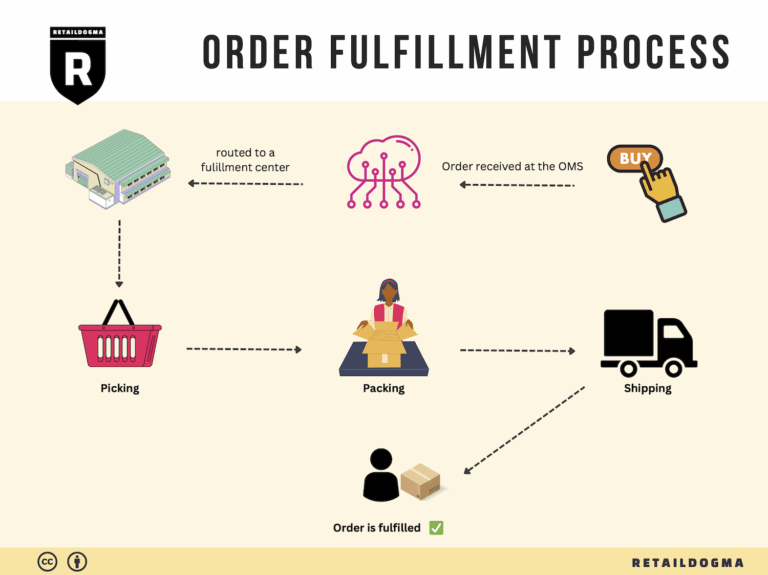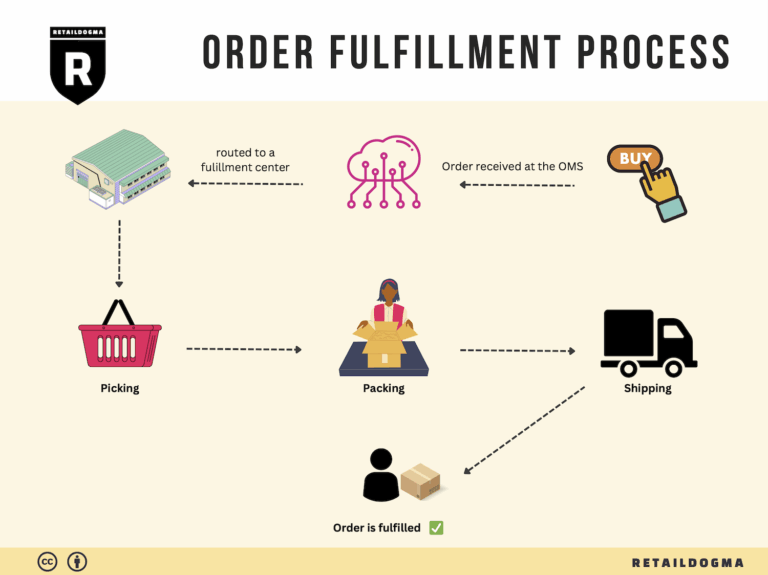Ecommerce Fulfillment Services: The Ultimate Guide (2025)
What is E-commerce Fulfillment? An Introduction for Growing Businesses
As your e-commerce business begins to scale, the excitement of increased sales can quickly be overshadowed by the complexities of packing and shipping orders. Many entrepreneurs find themselves overwhelmed by the sheer volume of logistics that come with fulfilling customer orders, often leading to inefficiencies and errors that can tarnish the customer experience. This is where e-commerce fulfillment comes into play.
Understanding E-commerce Fulfillment
At its core, e-commerce fulfillment is the process of getting a product from your inventory to the customer’s doorstep. This involves a series of steps, including inventory management, order processing, picking, packing, shipping, and handling returns. For growing businesses, navigating these processes can be challenging, particularly as the volume of orders increases. Efficient fulfillment not only enhances customer satisfaction but also allows you to focus on what you do best—growing your business.
What This Guide Will Cover
This comprehensive guide will delve into several critical aspects of e-commerce fulfillment to help you make informed decisions as you scale. You will learn about different fulfillment models, such as Third-Party Logistics (3PL) and Fulfillment by Amazon (FBA), and how each can fit into your business strategy. We’ll also explore the core services offered by fulfillment companies, including inventory management, shipping solutions, and returns processing.
Choosing the right fulfillment partner is crucial for your business. We will provide practical tips on evaluating potential partners, including key questions to ask and what to look for in terms of service levels and technology capabilities. Additionally, we will discuss pricing structures commonly found in the industry, helping you understand the costs associated with different fulfillment options and how they align with your budget.
Empowering Your Business Decisions
The ultimate goal of this guide is to empower you to make smart, strategic decisions about your logistics operations. By understanding the intricacies of e-commerce fulfillment, you will be better equipped to choose the right solutions that not only meet your current needs but also support your future growth. With the right fulfillment strategy in place, you can enhance operational efficiency, delight your customers, and ultimately drive your business toward greater success.
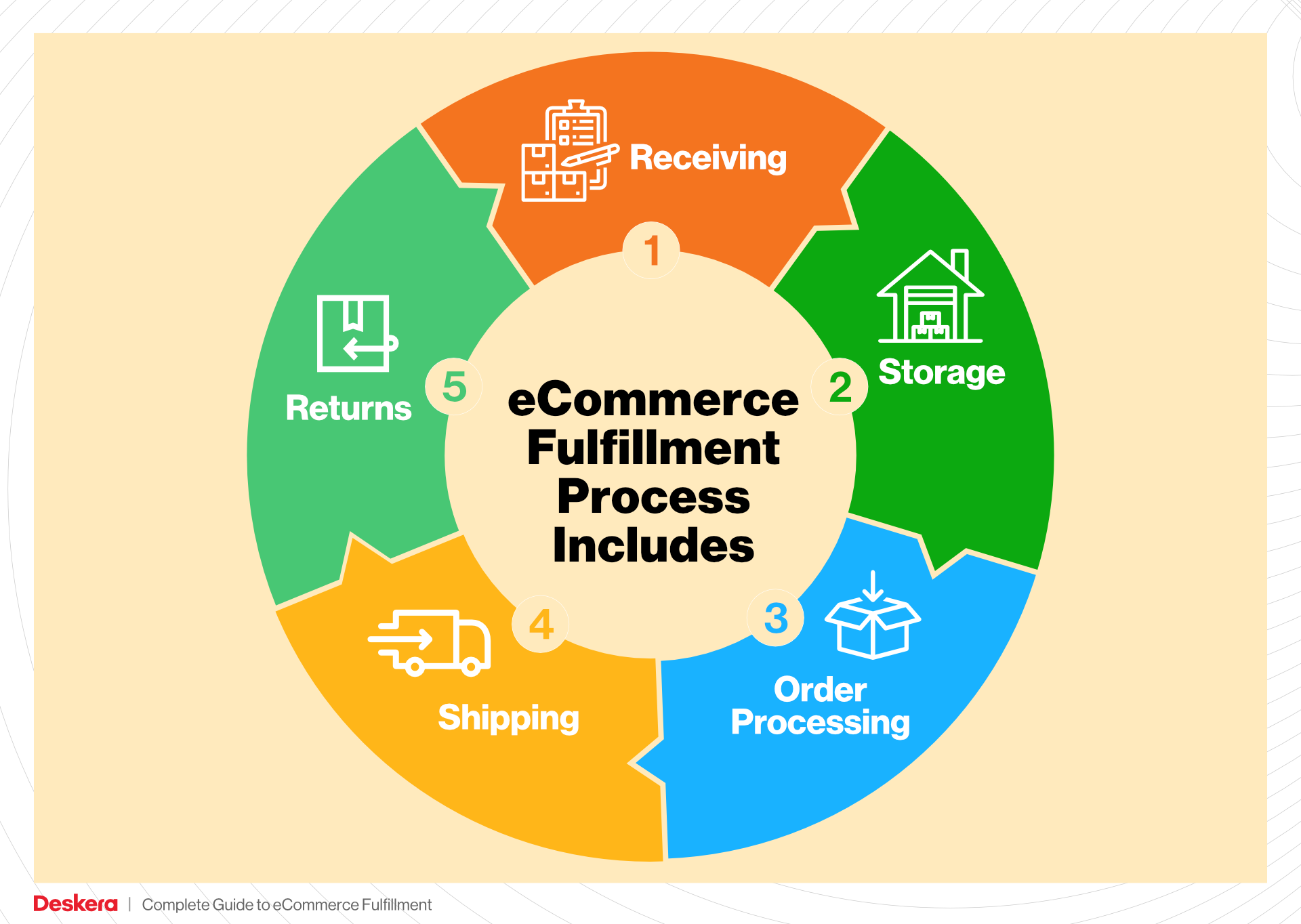
Let’s dive in and explore how to streamline your fulfillment processes and scale your e-commerce business effectively.
What You’ll Learn In This Guide
- What is E-commerce Fulfillment? An Introduction for Growing Businesses
- The Order Fulfillment Process: From ‘Buy’ Button to Customer’s Door
- Comparing Fulfillment Models: In-House vs. 3PL vs. Dropshipping
- A Deep Dive into Amazon FBA: Pros, Cons, and Who It’s For
- Core Services Offered by Fulfillment Centers
- How to Choose a Fulfillment Partner: A 6-Point Checklist
- Understanding Fulfillment Pricing: A Breakdown of Common Fees
- Frequently Asked Questions (FAQs) about Fulfillment
- Conclusion: Is Outsourcing Fulfillment the Right Move for Your Business?
- Important Disclaimer
The Order Fulfillment Process: From ‘Buy’ Button to Customer’s Door
1. Receiving Inventory
The order fulfillment process begins with receiving inventory, a crucial step that sets the foundation for effective logistics. When products arrive at your fulfillment center, they must be carefully inspected and recorded. This is where SKU (Stock Keeping Unit) numbers come into play. Each product should have a unique SKU that allows for accurate tracking and management within your inventory system.
Proper receiving ensures that you have an accurate count of what is in stock and that all items are in good condition. This step is essential for minimizing discrepancies that could lead to stockouts or overstock situations. Implementing a robust inventory management system can streamline this process, allowing you to update stock levels in real-time and maintain a clear picture of your inventory.
2. Warehouse Storage
Once inventory is received, the next step is warehouse storage. Efficient organization of your warehouse is critical for smooth operations. Products should be stored logically, often based on categories or sales velocity. This organization can be enhanced through the use of location codes, which help warehouse staff quickly identify where each item is stored.
The importance of proper storage cannot be overstated; it directly affects order picking speed and accuracy. A well-structured warehouse layout can reduce the time spent locating products, ultimately speeding up the fulfillment process. Additionally, implementing a first-in, first-out (FIFO) method can help manage perishable goods, ensuring that older stock is sold before newer arrivals.
3. Order Picking
Order picking is the process of retrieving products from the warehouse to fulfill customer orders. This step is critical, as it directly impacts order accuracy and customer satisfaction. A key term associated with this phase is the “pick list,” a document that outlines the items and quantities needed for each order.
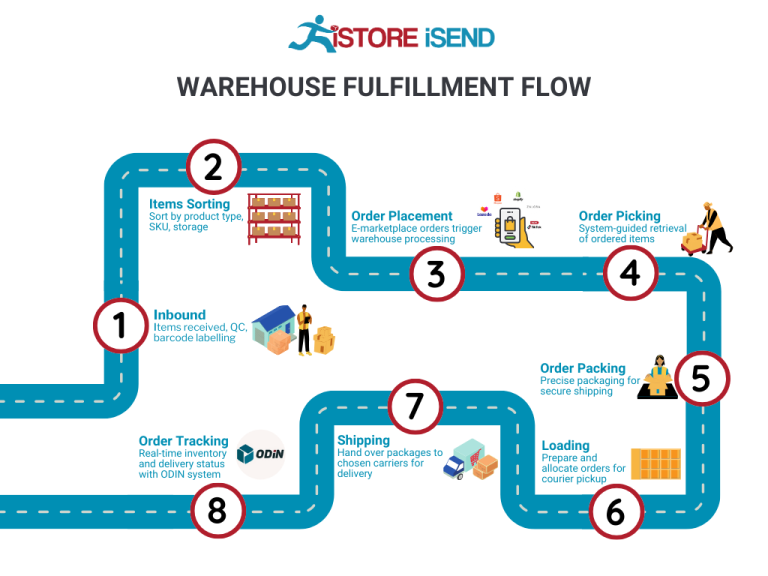
Using pick lists allows warehouse workers to efficiently gather the required items. There are various picking methods, such as single order picking, batch picking, and zone picking, each suited to different business models and order volumes. Implementing technology such as barcode scanners can further enhance accuracy and speed in this step, reducing the likelihood of errors that can lead to returns or customer dissatisfaction.
4. Order Packing
After the items have been picked, the next step is order packing. This phase is where products are prepared for shipment, and it plays a vital role in the unboxing experience for customers. Packaging should not only protect the products during transit but also reflect your brand identity.
Using branded boxes, custom inserts, and eco-friendly materials can enhance the customer experience and promote your brand. A key term to consider in this step is “packing slips,” which provide customers with a summary of their order and help warehouse staff ensure that all items are included. Additionally, implementing quality checks during the packing process can further minimize errors, ensuring that customers receive exactly what they ordered.
5. Shipping & Delivery
The final step in the order fulfillment process is shipping and delivery. This phase involves selecting the appropriate shipping method and carrier, as well as generating tracking information for customers. Key terms in this step include “shipping labels” and “last-mile delivery,” which refer to the final leg of the shipping journey from the distribution center to the customer’s door.
Effective shipping practices are crucial for maintaining customer satisfaction. Timely and accurate delivery can significantly impact repeat business and overall brand loyalty. Partnering with reliable carriers and utilizing shipping software can help you manage shipping costs and optimize delivery times. Additionally, providing customers with tracking information enhances transparency and keeps them informed about their order status, which can further improve their overall experience.
In conclusion, understanding and optimizing each step of the order fulfillment process—from receiving inventory to shipping and delivery—can significantly enhance your e-commerce operations. By implementing best practices and utilizing technology, businesses can improve efficiency, reduce errors, and ultimately drive customer satisfaction.

Comparing Fulfillment Models: In-House vs. 3PL vs. Dropshipping
Fulfillment Model Comparison
| Model | Who Handles Inventory | Best For (Business Stage) | Key Advantage | Key Disadvantage |
|---|---|---|---|---|
| In-House Fulfillment | Your own team | Established businesses | Full control over processes | High overhead costs |
| Third-Party Logistics (3PL) | External fulfillment provider | Startups to mid-sized firms | Scalable, cost-effective solutions | Less control over inventory |
| Dropshipping | Supplier or manufacturer | New entrepreneurs | Low startup costs | Lower profit margins |
In-House Fulfillment
In-house fulfillment involves managing your own inventory and logistics within your own facilities. This model is typically favored by established businesses that have already developed a stable customer base and have the resources to manage operations internally. The primary advantage of in-house fulfillment is that it provides full control over the entire process, from inventory management to packing and shipping. This can lead to improved quality control, faster response times, and the ability to create customized packaging that enhances the customer experience. However, in-house fulfillment comes with significant overhead costs, including staffing, warehousing, and equipment. Businesses must invest in technology and infrastructure to effectively manage their logistics, which can be a barrier for smaller companies or those just starting out. Additionally, as demand fluctuates, maintaining an efficient in-house operation can become challenging, leading to potential inefficiencies and waste.
Third-Party Logistics (3PL)
Third-party logistics (3PL) providers offer a robust solution for businesses looking to outsource their fulfillment processes. This model is ideal for startups and mid-sized firms that require scalability without the burden of managing logistics themselves. With a 3PL, businesses can leverage the expertise of fulfillment specialists who have established networks and systems for efficient inventory management, shipping, and returns processing. Key advantages include reduced operational costs, access to advanced technology, and the flexibility to scale operations up or down based on demand. A well-chosen 3PL can also improve shipping times and customer satisfaction through their established relationships with carriers. However, the primary disadvantage is the loss of some control over inventory and fulfillment processes. Businesses must trust that their 3PL will accurately manage their stock and uphold their brand standards, which can be a concern if the provider doesn’t meet expectations. Additionally, there may be hidden fees or minimum order requirements that could impact profitability.
Dropshipping
Dropshipping is a fulfillment model where the retailer does not hold inventory but instead relies on suppliers to ship products directly to customers. This model is particularly appealing to new entrepreneurs who may have limited capital and wish to minimize risk. The key advantage of dropshipping is the low startup costs, as there is no need to invest in inventory upfront or manage warehousing and shipping logistics. This allows businesses to offer a wide variety of products without the financial burden of maintaining stock. However, dropshipping also comes with significant disadvantages, including lower profit margins due to reliance on suppliers for pricing and fulfillment. Additionally, the retailer has little control over product quality and shipping times, which can lead to inconsistent customer experiences. If suppliers run out of stock or fail to deliver on time, it directly affects the retailer’s reputation. Furthermore, managing customer service issues can be challenging, as the retailer acts as a middleman between the customer and the supplier.
Conclusion
Choosing the right fulfillment model is crucial for e-commerce businesses as they scale. Each model—In-House Fulfillment, Third-Party Logistics (3PL), and Dropshipping—offers unique benefits and challenges. For established businesses with the resources to manage logistics, in-house fulfillment can provide control and customization. On the other hand, 3PL services offer a scalable, cost-effective solution for businesses looking to streamline operations without the overhead. Finally, dropshipping is an attractive option for new entrepreneurs looking to minimize upfront investment but comes with trade-offs in terms of control and margins. Understanding these models will help e-commerce owners and operations managers make informed decisions that align with their business goals and growth strategies.
A Deep Dive into Amazon FBA: Pros, Cons, and Who It’s For
Understanding Fulfillment by Amazon (FBA)
Fulfillment by Amazon (FBA) is a service offered by Amazon that allows e-commerce sellers to store their products in Amazon’s fulfillment centers. This service provides sellers with the ability to leverage Amazon’s vast logistics network, enabling them to scale their businesses efficiently while focusing on other core operations, such as marketing and product development.
How FBA Works
-
Product Preparation: Sellers prepare their products according to Amazon’s guidelines. This includes labeling, packaging, and ensuring that the products meet Amazon’s requirements for storage and shipping.
-
Shipping to Amazon: Once the products are prepared, sellers ship them to Amazon’s fulfillment centers. Amazon provides specific shipping plans that help sellers determine which fulfillment center to send their products to based on demand and logistics.
-
Storage: Amazon stores the products in their warehouses. Sellers are charged storage fees based on the amount of space their inventory occupies.
-
Order Processing: When a customer places an order for a product fulfilled by Amazon, Amazon handles all aspects of the transaction. This includes picking, packing, and shipping the product directly to the customer.
-
Customer Service and Returns: Amazon also manages customer service and returns for FBA orders, providing customers with the assurance of Amazon’s trusted service.
-
Payment: After the sale, Amazon deducts fees for storage and fulfillment before transferring the remaining funds to the seller.
Pros of Using FBA
1. Prime Eligibility
One of the most significant advantages of FBA is that products fulfilled through this service are eligible for Amazon Prime. This increases visibility and attractiveness to customers who prioritize fast and free shipping options, ultimately leading to higher sales.
2. Customer Trust
Amazon has established itself as a trusted platform for e-commerce transactions. By using FBA, sellers benefit from Amazon’s reputation, which can enhance customer confidence in purchasing products. The assurance of Amazon’s customer service and easy return policies can lead to increased conversion rates.
3. Multi-Channel Fulfillment
FBA offers the ability to fulfill orders not only from Amazon but also from other sales channels, such as eBay, Shopify, or a seller’s own website. This flexibility allows sellers to centralize their inventory and streamline their fulfillment processes across multiple platforms.
4. Scalable Operations
FBA allows businesses to scale rapidly without needing to invest heavily in warehousing and logistics infrastructure. Sellers can easily increase their inventory levels during peak sales periods without the burden of managing fulfillment logistics themselves.
5. Simplified Logistics
With FBA, sellers can offload logistics management to Amazon, which has a robust and efficient fulfillment network. This not only saves time but also allows sellers to focus on other aspects of their business, such as product development and marketing strategies.
Cons of Using FBA
1. High Fees
While FBA simplifies logistics, it comes at a cost. Sellers face various fees, including storage fees for keeping inventory in Amazon’s warehouses and fulfillment fees for order processing. These fees can accumulate quickly, particularly for sellers with low-margin products.
2. Strict Inventory Rules
Amazon has strict guidelines regarding inventory management and storage. Sellers must adhere to these rules to avoid penalties or potential account suspension. This includes maintaining appropriate stock levels and ensuring that products are not expired or damaged.
3. Commingling Risks
FBA operates on a system of commingling inventory, meaning that sellers’ products may be stored alongside those of other sellers. This can pose a risk if a customer receives a defective or subpar product that originated from another seller’s inventory, potentially leading to negative reviews or returns that impact the original seller’s reputation.
4. Limited Control Over Fulfillment
While Amazon handles logistics, sellers relinquish a degree of control over how their products are stored and shipped. This can lead to discrepancies in branding and packaging, which may not align with the seller’s marketing strategy or customer expectations.
5. Complexity in Returns Management
Although Amazon manages returns for FBA orders, the process can sometimes be complex. Sellers may face challenges if they want to handle returns differently or if they receive damaged goods back from customers, which could affect inventory levels and financials.
Who is FBA Best For?
Fulfillment by Amazon is best suited for:
-
Small to Medium-Sized Businesses: Those looking to scale without investing heavily in logistics infrastructure can benefit significantly from FBA. It allows them to focus on growth and product development.
-
Sellers with High Turnover Products: Businesses that sell products with high demand and turnover can leverage FBA’s fast shipping and Prime eligibility to maximize sales.
-
Multi-Channel Retailers: Brands that sell across various platforms can benefit from centralized inventory management and fulfillment, simplifying logistics.
-
New Entrepreneurs: Startups looking to enter the e-commerce space can utilize FBA to minimize initial operational challenges while they establish their brand and customer base.
However, businesses with low-margin products or those that require strict control over their inventory and fulfillment processes may want to consider alternative fulfillment solutions to avoid high fees and maintain more direct oversight.
In conclusion, FBA offers a unique opportunity for e-commerce sellers to streamline their operations and leverage Amazon’s vast network, but it is essential to weigh the benefits against the costs and challenges associated with the service.
Core Services Offered by Fulfillment Centers
Inventory Management & Warehousing
Effective inventory management and warehousing are foundational elements for any successful e-commerce operation. Fulfillment centers provide businesses with secure storage solutions for their products, ensuring that inventory is safely housed until it is ready to be shipped. These centers utilize advanced inventory management systems that offer real-time tracking and analytics, allowing businesses to monitor stock levels, forecast demand, and make informed purchasing decisions.
The benefits of robust inventory management are manifold. First, it minimizes the risk of stockouts or overstock situations, both of which can lead to lost sales or increased holding costs. By maintaining optimal inventory levels, e-commerce businesses can enhance customer satisfaction through timely order fulfillment. Additionally, many fulfillment centers offer flexible storage options, often without long-term commitments, enabling businesses to scale their inventory needs according to seasonal demand or promotional activities. This flexibility is essential for businesses looking to grow without being tied down by rigid warehousing contracts.
Pick and Pack Services
Pick and pack services represent a crucial function within fulfillment centers, streamlining the process of order fulfillment. This service involves the careful selection (picking) of items from inventory based on incoming orders and subsequently packing those items securely for shipment. Fulfillment centers employ trained staff and sophisticated systems to ensure high levels of accuracy and efficiency in this process.
For e-commerce businesses, the advantages of reliable pick and pack services are significant. High accuracy rates (often upwards of 99%) reduce the likelihood of shipping errors, which can lead to costly returns and dissatisfied customers. Moreover, efficient pick and pack processes accelerate shipping times, allowing businesses to meet customer expectations for quick delivery. This is particularly important in today’s fast-paced e-commerce landscape, where consumers increasingly demand rapid shipping options. Furthermore, many fulfillment centers offer branded packaging solutions, enhancing the customer experience and fostering brand loyalty through memorable unboxing moments.
Kitting and Assembly
Kitting and assembly services are increasingly valuable for e-commerce businesses that sell products requiring bundling or assembly before shipping. This service involves the grouping of individual items into ready-to-ship kits or the assembly of components into a final product. Fulfillment centers can handle a variety of kitting tasks, from simple combinations of products to more complex assembly processes.
The primary benefit of kitting and assembly services lies in their ability to save time and streamline operations for e-commerce businesses. By outsourcing these tasks to a fulfillment center, companies can focus on their core competencies, such as product development and marketing, rather than spending resources on labor-intensive assembly work. Additionally, kitting allows businesses to offer unique product bundles that can attract customers and increase average order values. This service can also facilitate promotional strategies, such as seasonal bundles or limited-time offers, ultimately driving sales and enhancing customer engagement.
Returns Management (Reverse Logistics)
Returns management, often referred to as reverse logistics, is a critical service provided by fulfillment centers that addresses the inevitable reality of e-commerce: product returns. A well-structured returns management process involves receiving returned items, inspecting them, restocking them if applicable, and updating inventory records accordingly. Fulfillment centers often streamline this process through automated systems that track returns and manage inventory seamlessly.
The benefits of effective returns management cannot be overstated. For e-commerce businesses, a hassle-free returns process can significantly enhance customer satisfaction and loyalty. Customers are more likely to complete a purchase if they know they can easily return items if needed. Moreover, efficient returns processing minimizes the financial impact of returns by quickly restocking sellable items and reducing the time products spend out of inventory. This not only helps maintain cash flow but also ensures that businesses can quickly respond to new sales opportunities. Additionally, thorough returns management can provide valuable insights into customer preferences and product performance, informing future product development and inventory strategies.
In conclusion, partnering with a competent fulfillment center can provide e-commerce businesses with a comprehensive suite of services designed to streamline operations, enhance customer satisfaction, and support growth. By leveraging these core services—inventory management and warehousing, pick and pack services, kitting and assembly, and returns management—businesses can focus on scaling their sales and improving their logistics without being bogged down by the complexities of fulfillment.
How to Choose a Fulfillment Partner: A 6-Point Checklist
Location & Warehouse Network
Importance:
The location of your fulfillment partner’s warehouses can significantly impact shipping costs and delivery times. A partner with strategically placed warehouses can reduce transit times to customers and lower shipping expenses.
Questions to Ask:
1. How many warehouses do you operate, and where are they located?
2. Can you provide coverage maps showing your service areas?
3. Do you have plans to expand your warehouse network in the near future?
4. How do you manage shipping logistics to ensure timely delivery?
Technology & Integrations
Importance:
A robust technological infrastructure is crucial for seamless operations. The ability to integrate with your existing e-commerce platforms ensures real-time inventory tracking, order processing, and overall visibility.
Questions to Ask:
1. What order management systems do you support?
2. Can your technology integrate with my e-commerce platform (e.g., Shopify, WooCommerce)?
3. Do you provide real-time tracking and reporting capabilities?
4. How frequently do you update your technology, and are there any additional costs for these updates?
Specializations (e.g., cold storage, oversized items)
Importance:
If your products require specific handling—such as temperature-controlled storage for perishables or specialized packing for oversized items—it’s vital to partner with a fulfillment provider that has the necessary capabilities.
Questions to Ask:
1. What types of products do you specialize in handling?
2. Do you offer specialized services such as kitting, cold storage, or hazardous materials handling?
3. Can you accommodate unique packaging requirements for my products?
4. How do you ensure compliance with safety and quality standards for specialized items?
Scalability & Capacity
Importance:
As your business grows, your fulfillment needs will evolve. Choosing a partner that can scale with your business ensures you can meet increased demand without disruption.
Questions to Ask:
1. How do you handle peak seasons or sudden spikes in order volume?
2. What is your current capacity for storage and order fulfillment?
3. Can you provide examples of how you have helped other businesses scale?
4. Are there any limitations on the types of products you can store or fulfill as we grow?
Pricing and Contracts
Importance:
Understanding the pricing structure is essential to avoid unexpected costs. Additionally, flexible contract terms can provide peace of mind as your business changes.
Questions to Ask:
1. What is your pricing model (e.g., per order, per item, monthly fees)?
2. Are there any hidden fees (e.g., setup, storage, or integration fees)?
3. What are your contract terms? Do you offer month-to-month agreements, or are long-term commitments required?
4. How do you handle price increases, and how will I be notified?
Customer Support & Reviews
Importance:
Exceptional customer support can make a significant difference in your experience with a fulfillment partner. A responsive support team can help quickly resolve issues, ensuring minimal disruption to your operations.
Questions to Ask:
1. What kind of customer support do you offer (e.g., phone, email, chat)?
2. What are your support hours, and how quickly can I expect a response?
3. Can you provide references or case studies from businesses similar to mine?
4. What measures do you take to ensure high customer satisfaction, and how do you handle complaints?
Conclusion
Choosing the right fulfillment partner is a critical decision that can influence your e-commerce business’s success. By using this checklist, you can systematically evaluate potential partners and ensure they align with your operational needs and growth objectives. Taking the time to ask the right questions will help you make an informed decision, allowing you to focus on scaling your business while your fulfillment partner manages the logistics.
Understanding Fulfillment Pricing: A Breakdown of Common Fees
Initial Setup Fees
Initial setup fees are common in the fulfillment industry and typically cover the costs associated with onboarding a new client. This can include creating a unique account for your business, integrating your e-commerce platform with the fulfillment center’s systems, and setting up inventory management protocols.
How It’s Calculated: Setup fees can vary significantly based on the complexity of the integration and the specific needs of your business. Some providers may charge a flat fee, while others may assess costs based on the number of products, SKUs, or the amount of data that needs to be transferred. To minimize setup costs, consider partnering with a fulfillment provider that offers no initial fees, as this can significantly reduce your upfront investment.
Receiving Fees
Receiving fees are charged when your inventory arrives at the fulfillment center. This fee covers the labor and resources needed to unload, inspect, and store your products. It may also include quality checks to ensure that the received goods match your order specifications.
How It’s Calculated: Receiving fees can be based on the volume of goods being received, typically charged per pallet or per item. Some providers may offer tiered pricing where the cost per unit decreases with larger shipments. To optimize receiving fees, plan your shipments to maximize the use of space and avoid sending frequent smaller deliveries.
Storage Fees (per pallet/bin)
Storage fees are incurred for the space your inventory occupies within the fulfillment center. This fee is crucial for managing your inventory levels, as it directly impacts your overall operational costs.
How It’s Calculated: Storage fees can be charged on a monthly basis, typically calculated per pallet or per bin. Some fulfillment centers also offer a tiered pricing model where the rate decreases with higher volumes of stored goods. Additionally, be aware of potential long-term storage fees, which may apply if products remain unsold for an extended period. To minimize storage fees, maintain a proactive inventory management strategy to ensure you are not overstocking items that have low turnover rates.
Pick & Pack Fees (per item/order)
Pick and pack fees are charged for the labor involved in selecting items from inventory and preparing them for shipment. This process includes picking the correct items, packing them securely, and labeling the packages for shipping.
How It’s Calculated: Fees for pick and pack services are usually charged per item or per order, depending on the fulfillment provider’s structure. Complex orders that require more time to assemble may incur higher fees. Some providers may also charge additional fees for special packing requests, such as branded packaging or kitting services. To keep these costs manageable, streamline your order processes and consider consolidating orders when possible.
Shipping Fees
Shipping fees are a significant component of fulfillment pricing, as they cover the cost of transporting your products to customers. This fee can vary based on multiple factors, including the shipping method, destination, package weight, and dimensions.
How It’s Calculated: Shipping fees are typically calculated based on weight and distance, with some providers offering flat-rate shipping options for specific regions or service levels. Additionally, partnerships with shipping carriers can influence pricing, so it’s advisable to choose a fulfillment provider with strong relationships with major carriers to secure better rates. To reduce shipping costs, consider negotiating bulk shipping rates or using a fulfillment center that offers discounted shipping options.
Tips for Getting an Accurate Quote
-
Provide Detailed Information: When requesting a quote, supply comprehensive details about your product types, order volumes, and any specific requirements. This will help the fulfillment provider give you a more precise estimate.
-
Ask About Hidden Fees: Inquire about any additional costs that may arise during the fulfillment process, such as handling fees, return processing fees, or special packaging fees. Understanding the full scope of potential charges will help you avoid surprises later.
-
Compare Multiple Providers: Obtain quotes from several fulfillment centers to compare pricing structures and services. Look beyond just the cost—consider factors like customer service, technology integration, and accuracy rates.
-
Consider Long-Term Needs: Think about your business’s growth trajectory. Choose a provider that can scale with your needs and offers flexible pricing models to accommodate changes in your order volume.
By understanding these common fulfillment pricing models and following these tips, you can make informed decisions that will help streamline your logistics operations and support your business’s growth.
Frequently Asked Questions (FAQs) about Fulfillment
1. What is a fulfillment center?
A fulfillment center is a specialized warehouse that focuses on order processing, storage, and shipping of products directly to customers. Unlike traditional warehouses, which primarily store goods, fulfillment centers manage the complete logistics of e-commerce operations, including receiving inventory, picking and packing orders, and handling returns.
2. What’s the difference between a warehouse and a fulfillment center?
While both warehouses and fulfillment centers store inventory, their functions differ significantly. A warehouse is primarily for storing goods and may not handle shipping or order fulfillment directly. In contrast, a fulfillment center is dedicated to processing orders, managing shipping logistics, and often includes additional services like kitting and returns management to support e-commerce businesses.
3. What is a 3PL (Third-Party Logistics) provider?
A 3PL provider is a company that offers logistics services to businesses, including warehousing, order fulfillment, inventory management, and shipping. By partnering with a 3PL, e-commerce companies can outsource their logistics operations, allowing them to focus on core business activities such as marketing and product development.
4. How much do fulfillment services cost?
Fulfillment service costs can vary widely based on factors such as storage space, order volume, and additional services like kitting or returns management. Typically, fulfillment companies charge for storage (per cubic foot or pallet), picking and packing (per order or item), and shipping (based on weight and destination). It’s essential to obtain quotes from multiple providers to compare pricing effectively.
5. How do I choose the right fulfillment partner?
When selecting a fulfillment partner, consider factors such as their experience in your industry, technology capabilities, shipping options, customer service quality, and pricing structure. It’s also beneficial to read customer reviews and request case studies to understand how they have supported similar businesses in scaling their operations.
6. Can fulfillment centers handle international shipping?
Yes, many fulfillment centers offer international shipping services. They typically have established partnerships with shipping carriers and can navigate customs regulations, ensuring that your products reach global customers efficiently. Be sure to confirm the provider’s experience with international logistics and any associated costs.
7. What technology do fulfillment companies use?
Fulfillment companies use various technologies to streamline operations, including inventory management systems, order processing software, and shipping integration tools. These technologies allow businesses to track orders in real-time, manage stock levels, and automate routine tasks, ultimately improving efficiency and accuracy in order fulfillment.
8. How do fulfillment services manage returns?
Fulfillment services often include returns management as part of their offerings. This process involves receiving returned items, inspecting them for quality, restocking them if they are in sellable condition, and updating inventory records. Efficient returns management is crucial for maintaining customer satisfaction and minimizing losses.
9. What are the benefits of using a fulfillment service?
Utilizing a fulfillment service can provide several advantages, including cost savings on shipping, access to advanced logistics technology, scalability as your business grows, improved order accuracy, and enhanced customer satisfaction through faster delivery times. It allows businesses to focus on growth while leaving logistics to the experts.
10. How long does it take to fulfill an order?
Order fulfillment times can vary based on the fulfillment center’s processes, the complexity of the order, and the shipping method chosen. Generally, most fulfillment centers aim to process orders within 24 to 48 hours after receiving them. However, shipping times will depend on the carrier and the destination, so it’s essential to communicate expectations with your fulfillment partner.
Conclusion: Is Outsourcing Fulfillment the Right Move for Your Business?
Evaluating the Benefits of Outsourcing Fulfillment
As an e-commerce business owner, the decision to outsource fulfillment can be transformative. Partnering with a third-party logistics provider (3PL) allows you to save significant time by offloading the complexities of warehousing, inventory management, and shipping logistics. This time-saving translates into more bandwidth for you to focus on core business activities like marketing, product development, and customer engagement—key areas that drive sales and growth.
Scalability is another compelling reason to consider outsourcing. A reliable fulfillment partner can adapt to your business’s changing needs, whether you experience seasonal spikes in demand or plan for long-term growth. This adaptability ensures that you can fulfill orders efficiently without the burden of managing excess inventory or expanding your warehouse space.
Moreover, 3PL providers bring specialized expertise to the table. They possess a wealth of experience in logistics management, shipping regulations, and cost optimization. This expertise not only enhances operational efficiency but also contributes to improved customer satisfaction through faster, more reliable delivery services.
However, it’s crucial to select the right fulfillment partner to truly harness these benefits. A misaligned partnership can lead to bottlenecks, miscommunication, and ultimately, customer dissatisfaction.
Take Action: Audit Your Current Shipping Process
Now is the time to assess your current shipping and fulfillment processes. Conduct an audit to identify inefficiencies, bottlenecks, and areas where your business could benefit from expert support. Ask yourself: Are you facing challenges with inventory management? Are shipping costs eating into your margins? If the answer is yes, exploring a fulfillment partnership could be your next strategic move. Start this journey by researching potential 3PL providers, requesting quotes, and understanding how they can help elevate your business.
Important Disclaimer
⚠️ Important Disclaimer
The information in this guide is for educational purposes. Fulfillment services, pricing, and platform features change frequently. Always conduct your own due diligence and consult with providers directly before making business decisions.
